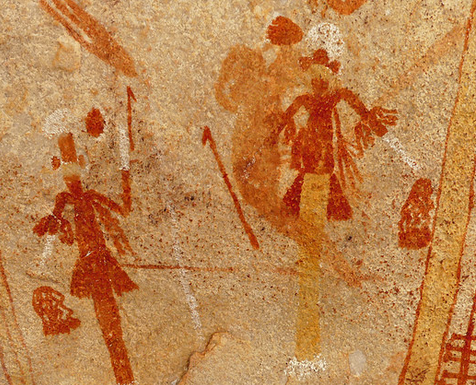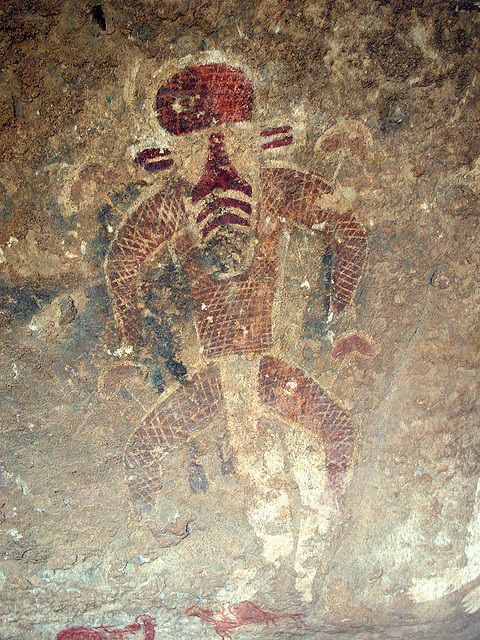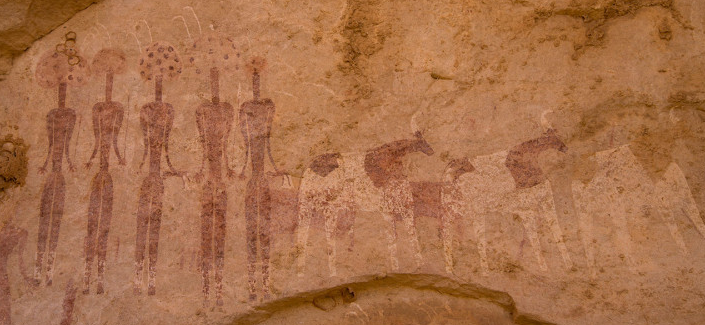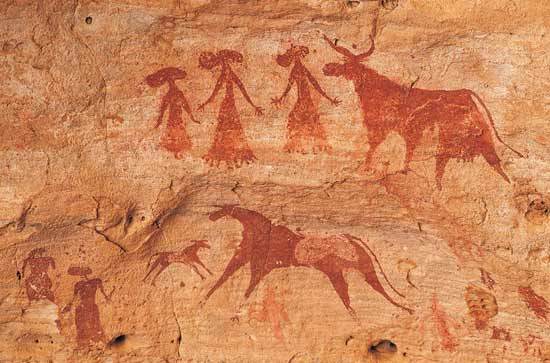Ancient Psychedelia: Alien Gods & Mushroom Goddesses
Online Book - Chapter 1, Page 7
Back to Online Book Mainpage / Next Page (Chapter 1, Page 8)
 (1d) Mitchell River, Queensland, Australia Tassili n'Ajjer in the Sahara Desert in southeast Algeria, contains depictions of mushrooms which are said to date to approximately 10,000 BC. The shamanic nature of the artwork is clearly evident in some of the images at Tassili, where animal transmorphic art depicts human shaped animals or beast people with mushrooms emerging from them (4a), as well as images of mushroom headed people standing next to bulls (4e).  (4a) Tassili n'ajjer, Algeria c. 10,000 BC  (4e) Tassili n'ajjer, Algeria c. 10,000 BC |
More frequently, mushroom-headed “people” are seen dancing around, which is a common depiction on cave art all over the world. This fact alone indicates that either there was one group of humans who went around the world spreading this knowledge through cave systems or this thought evolved spontaneously like the hundredth monkey all over the world during a common era. The other common depiction on this early cave art are horned animals, more commonly steer, such as bulls or cows. There is a preponderance of these in much of the early Tassili artwork. We also have artwork from Tassili which depicts humans riding a two-wheeled cart being driven by an animal, likely a deer. It could also be a horse, but the drawing appears to have small horns placed on the head. It’s difficult to say which animal it is for certain. What is clear is that there are wheels on the cart, and it’s being driven by an animal. It is from Cucuteni (Romanian/Ukrainian) pottery, c. 3900 BC, where we get the first evidence of wheeled vehicles in the form of a bull with wheels on it being depicted, and previously, it was assumed by some scholars that this was the beginning of the horse-drawn chariot. (24) Clearly, the cave depiction from Tassili are far older. In Chad, in north central Africa, at the Ennedi Plateau, there are rock engravings thoughts to be as old as 12,000 years or more and cave art dating from 4000-9000 years back. Several of these images depict mushroom headed people standing next to cows or bulls (7a). There are also depictions of camels and birds as well, and it’s apparent that culture had evolved quite a bit. The mushroom grows from the bull and cow dung as well as other bovine animals. This relationship of early man to the bovine species is the central key to understanding the mushroom’s influence upon world religions. In America we have a very nice example of the bull or cows and the mushroom together (7e).  (7a) Ennedi Plateau, Chad c. 7000-2000 BC (24) Russell, Shamanism and Drug Propaganda, p.46 |
Go Back to Page 6